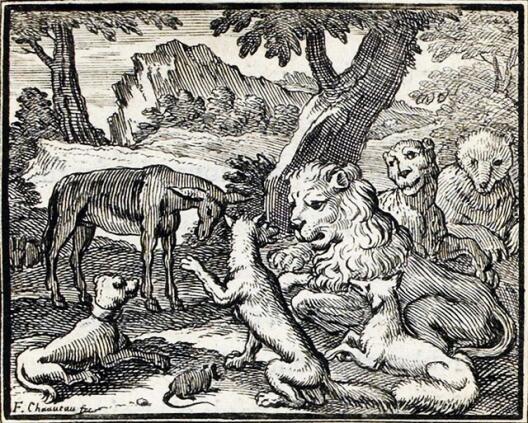Calling a spade a spade: literary talk about the plague in La Fontaine’s fable “Les animaux malades de la peste”
By literary scholar Pia Claudia Doering (Romance studies)
Language provides us with a multitude of possibilities to articulate the invisible and the unimaginable. Only by naming them do phenomena become tangible and negotiable, and the names then shape our ideas.
Terms are often used to denote epidemics that have a specific relationship to the disease in question: mortalitas magna (“the Great Death”), for example, refers to the high mortality rate and omnipresence of the medieval plague; mors nigra (“the Black Death”) probably derives from one of its symptoms, the bluish-black colouring of the skin of plague sufferers; and the abstract sounding name Covid-19, the abbreviation for Corona Virus Disease 2019, is based on a visual idea of the pathogen, since under a microscope the viruses have the form of a wreath (lat. corona).
Literature has an effective linguistic means to make vivid the threatening powers to which humans are exposed, whose origins lie in the religious context: the naming taboo, i.e. deliberately refraining from naming, thereby making a paraphrase necessary. In La Fontaine’s fable “Les animaux malades de la peste” (“The animals sick of the plague”, 1678), the narrator applies the game of paraphrase and emphatic naming to the plague. The fable begins as follows:
| 1 Un mal qui répand la terreur, Mal que le Ciel en sa fureur Inventa pour punir les crimes de la terre, La Peste (puisqu’il faut l’appeler par son nom) 5 Capable d’enrichir en un jour l’Achéron, |
The sorest ill that Heaven hath Sent on this lower world in wrath, Invented to punish the crimes of the earth The plague (to call it by its name) |
| Faisait aux animaux la guerre. Ils ne mouraient pas tous, mais tous étaient frappés : On n’en voyait point d’occupés À chercher le soutien d’une mourante vie ; |
Able to enrich Acheron in one day Waged war on beasts, both wild and tame. They died not all, but all were sick: No hunting now, by force or trick, To save what might so soon expire. |
| 10 Nul mets n’excitait leur envie ; Ni Loups ni Renards n’épiaient La douce et l’innocente proie. Les tourterelles se fuyaient : Plus d’amour, partant plus de joie. |
No food excited their desire; |
| In: Jean de La Fontaine, Œuvres complètes, hg. v. Jean-Pierre Collinet, Paris 1991, Bd. 1, S. 249. | In: Jean de La Fontaine, Œuvres complètes, hg. v. Jean-Pierre Collinet, Paris 1991, Bd. 1, S. 249. |
In the first three lines, the narrator omits the name of the plague. The terror that it spreads is emphasized by the anaphoric repetition of the word “mal” and the rhyme “terreur/fureur”. Finally, the description culminates in the act of naming “La Peste” in line 4, with the clause in brackets (“puisqu’il faut l’appeler par son nom”) indicating the effort that it takes to say the name aloud.
It has already been shown that the tabooing of a name for fear of evoking an evil by naming it was present in ancient Greek religion, where, for example, the Furies, those goddesses of the underworld who take revenge and spread madness, are not given their actual names, but referred to euphemistically (if at all). But even the poets of antiquity, including Sophocles and Euripides, play with the juxtaposition of silence, euphemistic paraphrase, and explicit naming. Young contemporary readers are also familiar with the effect of a naming taboo from J.K. Rowling’s Harry Potter novels. In the magical world, few dare to pronounce the name of the terrible Lord Voldemort. Instead, people use clichéd expressions such as “You-Know-Who” and “He Who Must Not Be Named”. The protagonist’s mentor, Albus Dumbledore, advises his protégé not to submit to the tabooing of the name: “Call him Voldemort, Harry. Always use the proper name for things. Fear of a name increases fear of the thing itself” (J.K. Rowling, Harry Potter and the Philosopher’s Stone, p. 320).
La Fontaine’s fable shows that it is precisely the interplay between the naming taboo and the act of uttering the name that can have a great effect, since the ‘eloquent silence’ of the taboo on names and the interpretation of evil as divine punishment for human sins already arouses the worst fears. The tension thus created is discharged in the phrase “La Peste”, which in turn invests it with particular terror.
The narrator’s emphatic naming of the plague precedes images, metaphors and allegories that illustrate the consequences of the epidemic: including the image of the Acheron River filling up with the dead in just one day, the metaphor of war, and the allegory of turtledoves fleeing from each other as a symbol of the loss of love, closeness, and joy. Within a few lines, the fable thus combines three literary methods – paraphrasing, emphatic naming, and vivid depiction – to make tangible the almost incomprehensible terror of the plague and its profound effects on society.


